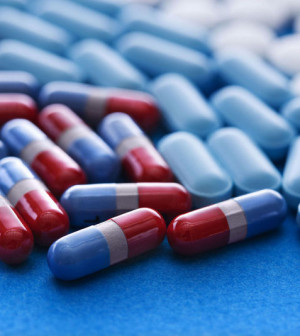- Navigating Your Midlife Crisis: Embracing New Possibilities
- City Raccoons Showing Signs of Domestication
- Mapping the Exposome: Science Broadens Focus to Environmental Disease Triggers
- One Week Less on Social Media Linked to Better Mental Health
- Your Brain Changes in Stages as You Age, Study Finds
- Some Suicide Victims Show No Typical Warning Signs, Study Finds
- ByHeart Formula Faces Lawsuits After Babies Sickened With Botulism
- Switch to Vegan Diet Could Cut Your Greenhouse Gas Emissions in Half
- Regular Bedtime Does Wonders for Blood Pressure
- Dining Alone Could Mean Worse Nutrition for Seniors
HPV Vaccine Produces Early Benefits for Teen Girls: Study


Girls as young as 14 are receiving important health benefits from the HPV vaccine, which protects against a sexually transmitted virus that causes cervical cancer, a new study reports.
Canadian girls who received the vaccine around age 13 experienced a “large and significant reduction” in cases of cervical dysplasia — an abnormal precancerous lesion caused by human papillomavirus (HPV) — at ages 14 to 17, researchers found.
Additionally, the girls suffered fewer cases of genital warts, which are also caused by HPV.
“Cervical dysplasia and genital warts can happen as soon as a girl becomes sexually active, more or less,” said lead author Leah Smith, a postdoctoral fellow at the Queen’s University Center for Health Services and Policy Research in Ontario, Canada.
“Some parents have been delaying vaccination for their daughters until they’re older, because they don’t think they are sexually active,” Smith continued. “These results show this age group is sexually active and they are at risk. The vaccine really needs to be given before the girls are at risk.”
The HPV vaccine is recommended for both girls and boys ages 11 or 12. HPV vaccination rates have continued to lag in the United States, even though the vaccine has been available to girls since 2006.
Currently, only about half of women have received one dose of the vaccine, and just a third have received the entire three-dose course, said Debbie Saslow, director of Breast and Gynecologic Cancer at the American Cancer Society.
“This is about preventing cancer,” Saslow said. “Here we finally have a vaccine that can prevent cancer, and parents are not running to get their kids protected.”
Cervical cancer does not occur until later in life, but the study authors suspected that some girls are nonetheless receiving important protection from the HPV vaccine within a few years of inoculation, Smith said.
To evaluate those benefits, the researchers tracked the health of more than 260,000 girls. Half of the girls were eligible for a school-based program that offered the vaccine free of charge to all eighth-grade girls. The other half were in grade 8 prior to the program, which started in 2007.
The researchers looked for cases of cervical dysplasia and genital warts in the girls because these tend to be the earliest signs of HPV infection, Smith said.
Cervical dysplasia is “not yet cancer, but over time, if it’s left untreated and unchecked runs the risk of becoming cancer later in a girl’s life,” said senior author Linda Levesque, an assistant professor at the Queen’s University Center for Health Services and Policy Research.
More than 2,400 cases of cervical dysplasia occurred in these girls between grades 10 to 12. However, the risk of cervical dysplasia was reduced by 44 percent in girls who received the vaccine, the study reports.
“This basically means that for every 175 girls who received the HPV vaccine, one fewer case of cervical dysplasia occurred,” Smith said. “One case was prevented.”
The researchers also found that girls eligible for free HPV vaccination ended up with fewer cases of genital warts, although the finding was not statistically significant.
“I don’t think we were surprised the vaccine works,” Levesque said. “What I was surprised by was the magnitude of benefits in such a young age group. I expected we would see some reductions. I didn’t think they would be so large and of such significance.”
Girls can receive the vaccine as young as 9, but health officials in the United States recommend the vaccine at 11 or 12, at the same time as other important adolescent vaccinations like tetanus/diphtheria/pertussis and meningitis, Saslow said.
This study involved the first HPV vaccine available on the United States and Canadian markets, Gardasil 4, which protects against four strains of human papillomavirus. Since then, two other vaccines — Cervarix, which protects against two strains, and Gardasil 9, a new version of Gardasil that protects against nine strains — have been approved in the United States.
Girls and boys both receive the HPV vaccine in a three-shot series within a six-month time frame.
Many parents and health care providers are hung up on the fact that the vaccine is for a sexually transmitted virus, and fail to grasp that it is the first vaccine to actually prevent cancer, Saslow said.
She recommends that kids “just get the vaccine at age 11 or 12, because that’s when it’s recommended.” Waiting longer could mean a less potent immune response from the adolescent, which leads to less effective protection against cervical cancer.
“We don’t know when you’ll be exposed to the measles. We don’t know when you’ll step on a rusty nail and risk tetanus,” Saslow said. “With vaccines, you don’t wait until the risk is higher. You go when your immune response is the strongest. Let’s not make this about sex. It’s about preventing cancer.”
The study, published online April 27 in Pediatrics, resulted from a collaboration between researchers at Queen’s University and McGill University in Montreal.
More information
For more information on the HPV vaccine, visit the U.S. Centers for Disease Control and Prevention.
Source: HealthDay
Copyright © 2025 HealthDay. All rights reserved.










